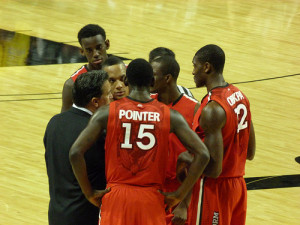5 Things you can do to Coach Better on Court
Every coach worth their salt works hard to refine their craft and Coach Better on court. It is not just good enough for a coach to be able to plan and present your training sessions. To truly master being a high quality coach you must communicate in an effective and efficient manner. Communicating with purpose is important but many people agree that it is often how the message is presented which ultimately leads to the receiver understanding and being able to take that message and demonstrate what is needed on the floor.
As a coach you need to be a student of the game. This means not only watching basketball games, attending workshops, researching and coaching. But evaluating why you do what you do and how this can be improved in an honest and truthful manner. A great strategy for many coaches is to undertake the evaluation and review process only to argue with the feedback sighting their own coaching style. Individual coaching flare is not the enemy here, but there are some principles which will help your coaching from juniors to elite levels within sports in general.
At the core to coach better on court is to have your player’s attention. Have your players when you are explaining information Stop, Look and Listen. Most people struggle to do two things at once to a very high standard. Multi-tasking while a very real skill, is not that easy to master and people who truly have this ability are few and far between. When giving initial instruction you must have you player’s attention. Once you give the initial cue for your players to stop what they are doing and to pay attention wait until you have their undivided attention. There are plenty of ways to make this reaction time happen faster and faster but you don’t want to waste an opportunity to deliver you message and condemn yourself to having to repeat your message over and over again.

Eye Contact is another aspect as a coach you need to become comfortable with. Eye contact lets your players know you are talking to them and they need to be paying attention to you. Eye contact is a great tool for the coach to assess players understanding. When you look at a player and they have that blank expression on their face try to rephrase what you are saying to help maximise understanding throughout the group. To ensure you coach better on court you should try to push through the uncomfortable feeling some people have about eye contact. Your eye contact in the coaching context is not about intimidating, but rather a demonstration of your focus and concentration in having the message delivered to your players.
Confirm players are Hearing what you are Saying, not just listening. All too often as coaches we become comfortable with our own knowledge, teaching points, phases and mannerisms. Our players however are not us and they have their own personal communication filters when receiving messages. All players apply their own interpretation to the message being sent. If you are lucky enough to be working with players over multiple seasons then this margin for interpretation becomes less and less. But no matter the relationship with the players you should always confirm they understanding what needs to be done, the points of emphasis and anything else you think needs to be highlighted. This can be done easily through asking questions or selecting individuals to volunteer to demonstrate for the group. This ensures that you coach better on court by reaffirming your key points to the players.
As a nice little side effect some players will pay more attention because they don’t want to be caught out if asked a question.
Deliver your message within Three Main Points. So what is important about the power of three? A significant percentage of people can remember only three points before they start to lose focus and as a result their understanding deteriorates. Likewise a similar percentage of people are at the opposite end of the scale and can remember up to seven points. These people are able to take multiple pieces of information and still remember them. The majority of people however can only remember five points before their short term memory starts to fail. The moral of the story is by speaking with three main points to your message you will cover everyone in the group and ensure the maximum opportunity for take up of the direction. If you want to coach better on court this is the most important of the five points.
Manage your Immediate Space is important to limit distractions and provide the best possible stage for direction to be given. Some coaches move players onto the sidelines and ensure their feet are touching the line so they are facing towards the coach. There are plenty of ways of providing a line of sight for your players during demonstrations, a point of note should be that you can see them from head to toe. No hiding behind others or leaning around someone to see.
If you are fortunate enough to be coaching outside make sure your players backs are towards the sun when providing direction. It is a common mistake but coaches to stop a drill or activity to give direction and accidently have their players looking into the sun. Obviously this does not help with the theme of creating an optimum environment for learning to occur.
These five points to help you coach better on court are not going to solve all your issues, but they will make a difference in being able to communicate in a more supportive way to help your players be the best they can be. You should be endeavouring every six months at the very least to have someone look at your training session or a game to provide some insight and different perspective on what you can do.







